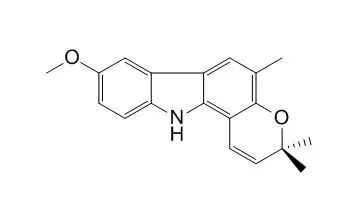| Structure Identification: |
| Natural product communications, 2014, 10(2). | | QuantitativeAnalysis of BioactiveCarbazole Alkaloids in Murraya koenigii(L.) Spreng.[Reference: WebLink] | Carbazole alkaloids induce apoptosis in HL-60 cells through activation of the caspase-9/caspase-3 pathway and they are targeted as potential anticancer agents. Thus, the naturally occurring carbazole alkaloids become important as precursors for lead optimization in drug development.
METHODS AND RESULTS:
A method based on ultra performance liquid chromatography coupled with photodiode-array detection was developed using reverse phase isocratic elution with 85:15 acetonitrile and ammonium acetate buffer (5 mM). Seven samples of Murrya koenigii (L.) Spreng. from north-central India (Uttar Pradesh) were analyzed. All three targeted analytes, koenimbidine (mk1), Koenimbine (mk2) and mahanimbine (mk3), were well separated within 4.0 min with linearity of the calibration curves (r2 > 0.999). The limits of detection and quantification of mk1, mk2 and mk3 were 0.7, 0.4, 0.04 μg/mL and 2.14, 1.21, 0.12 μg/mL, respectively. The natural abundance of mk1, mk2 and mk3 was 0.06-0.20, 0.04-0.69 and 0.13-0.42%, w/w, respectively, in the dried powdered leaves, whereas, the tissue specific distribution of carbazole alkaloids was observed in the order of predominance, mk1 leaf>root>fruit>stem, mk2 fruit>leaf >stem>root, and mk3 fruit>leaf>root>stem. The developed method was validated for limits of detection and quantification, repeatability, accuracy, precision and stability.
CONCLUSIONS:
This is the first report on the natural abundance of the major carbazole alkaloids in M. koenigii and the method developed can be used in HPLC/UPLC systems. |
|






 Cell. 2018 Jan 11;172(1-2):249-261.e12. doi: 10.1016/j.cell.2017.12.019.IF=36.216(2019)
Cell. 2018 Jan 11;172(1-2):249-261.e12. doi: 10.1016/j.cell.2017.12.019.IF=36.216(2019) Cell Metab. 2020 Mar 3;31(3):534-548.e5. doi: 10.1016/j.cmet.2020.01.002.IF=22.415(2019)
Cell Metab. 2020 Mar 3;31(3):534-548.e5. doi: 10.1016/j.cmet.2020.01.002.IF=22.415(2019) Mol Cell. 2017 Nov 16;68(4):673-685.e6. doi: 10.1016/j.molcel.2017.10.022.IF=14.548(2019)
Mol Cell. 2017 Nov 16;68(4):673-685.e6. doi: 10.1016/j.molcel.2017.10.022.IF=14.548(2019)